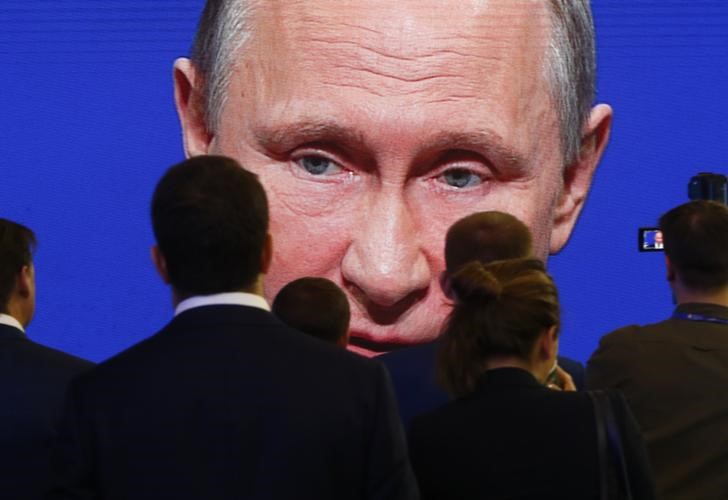(Bloomberg Opinion) -- The Russian central bank reports that the state’s share of banking assets hasn’t increased, even though it has been taking over and closing private lenders for the past year. The Russian banking system is on a path toward almost total nationalization, and the central bank is pushing it along.
The Bank of Russia relies on an accounting trick to buttress its claims about the sector’s performance in 2017. It analyzed banks by ownership type, but created a separate category for lenders under external management that didn’t exist in previous years. Even though the central bank itself and the state deposit insurance agency took over over these allegedly distressed financial institutions, they aren't counted toward the government-owned quota. That allowed the central bank to say that the state-controlled lenders’ share of total assets only increased to 58.5 percent from 58.3 percent in 2016.
In reality, the distressed banks under state management, which included five of the top-20 Russian banks by assets in 2017, should be added to the government-owned lenders. Then, the government-controlled share of banking assets would rise to 70.7 percent, the highest in Russia’s post-Soviet history.
Last year, the state-controlled banks, including the distressed ones, held almost 55 percent of private deposits and issued 78 percent of all loans to companies outside the banking sector, as well as 72 percent of loans to individuals. Among large countries, such levels are only seen in China and India, where the banking systems are state-dominated by design. Russia’s isn’t: It was set up in the 1990s to foster competition and allow the broad participation of foreign and private banks.
According to a World Bank working paper published in January, and only used data up to 2010, Russia’s current degree of bank nationalization stands out among capitalist economies, despite a global wave of nationalizations during the global banking crisis.
In the working paper, Robert Cull, Maria Soledad Martinez Peria and Jeanne Verrier wrote:
Overall, there is little evidence that government bank ownership provides substantial benefits (relative to other types of ownership) to the banking sector, the real economy, or users of banking services, especially in developing countries. While there is some recent evidence that government-owned banks can help stabilize credit growth during crises, in general, they have had a negative impact on competition and banking performance and their record in expanding access to credit is, at best, mixed.
That’s one reason the Bank of Russia isn’t eager to publicize the rollback of private ownership. Another may be that President Vladimir Putin said at his annual press conference late last year that the Russian banking sector wasn’t being nationalized. “That is not so,” he said, pointing out that Russia had more than 500 banks. “If the central bank takes something over, that’s with the purpose of eventual privatization.”
That would make sense. Last year, the regulator reports, injections of capital into the distressed banks under state management were the biggest source of extra liquidity for the Russian banking system. Perhaps that money someday will be repaid by the recapitalized banks’ new private owners. In reality, however, a big Russian bank hasn’t been acquired by a private buyer in a very long time. Only government-controlled entities are in the market. In the next few days, the state-controlled lender VTB is expected to announce the takeover of Vozrozhdeniye, the nation’s 40th bank by assets. Its controlling shareholder, Dmitry Ananyev, is being forcing to sell by the central bank. Ananyev was the owner of one of the big distressed banks, Promsvyazbank. Last year, after the regulator assumed control of that institution, he left Russia, presumably to avoid further trouble.
At the same time, the Bank of Russia is warning the remaining private lenders that they're vulnerable. The report for 2017 contains the generalized results of a stress test of Russian banks’ preparedness for an oil price drop to $25 a barrel (Brent oil is at $76 now) and a 3.9 percent decline in economic output. The test showed that 127 lenders out of 561 would face a liquidity crisis under these circumstances. They hold 40.9 percent of Russian banking assets; they likely include the banks under external management, but also a large share of financial institutions that are still private. The stress test shows the central bank considers them at risk if the economy has a downturn.
Nationalization, in a way, makes the Russian banking system safer. It’s hard to imagine how the government or the central bank would allow a state-controlled bank to go under. At the same time, central bank officials feel more comfortable having a hand in the actual running of banks than trying to regulate them. That way, they reduce the probability of high-profile bank runs and crashes that would arouse Putin’s ire.
For the country’s non-financial sector, however, the continuing takeover offers a greater dependence on the state, which is monopolizing credit resources.
Putin has set ambitious economic targets for his fourth term in power: Higher growth than in the rest of the world, halving the poverty rate, a jump to fifth place among the biggest economies (Russia was 11th last year). A government-controlled banking system isn't likely to help reach these goals. Unless private investors suddenly emerge to buy the lenders under restructuring today, the takeover by the state will drag down growth and contribute to a climate in which the state is the only player that matters.
